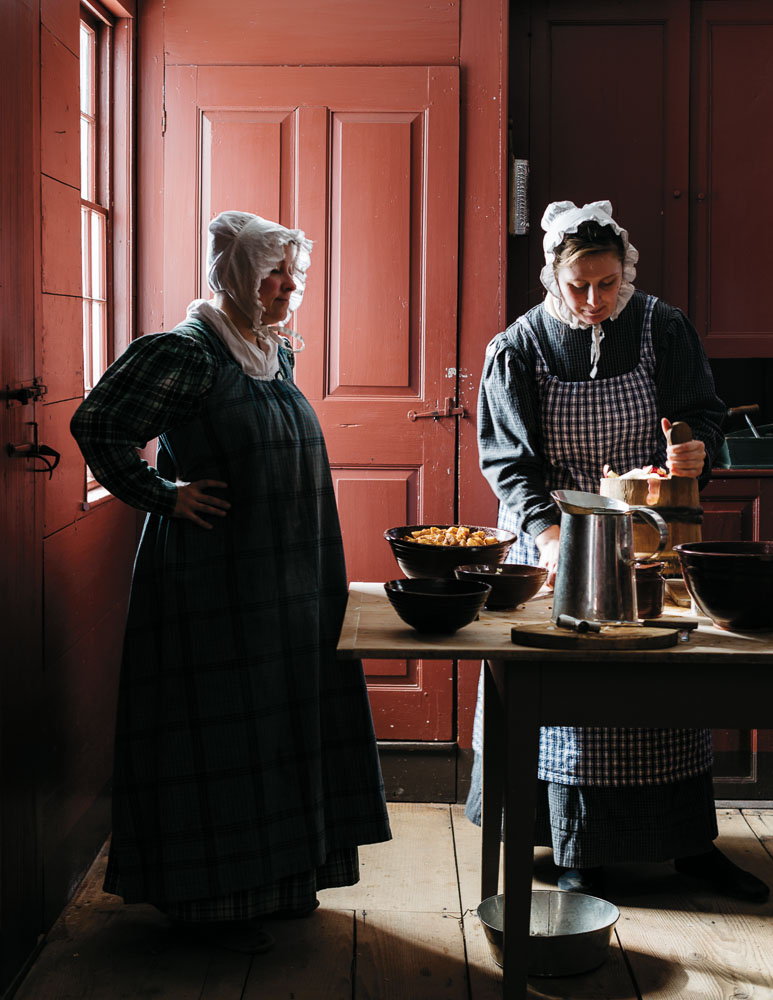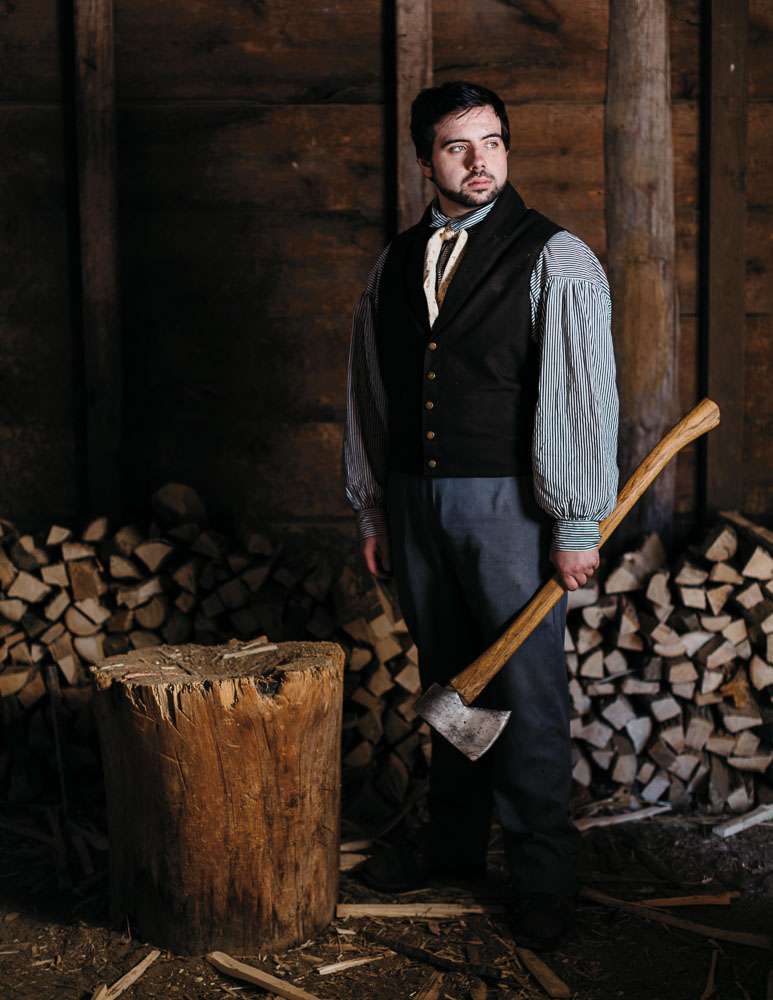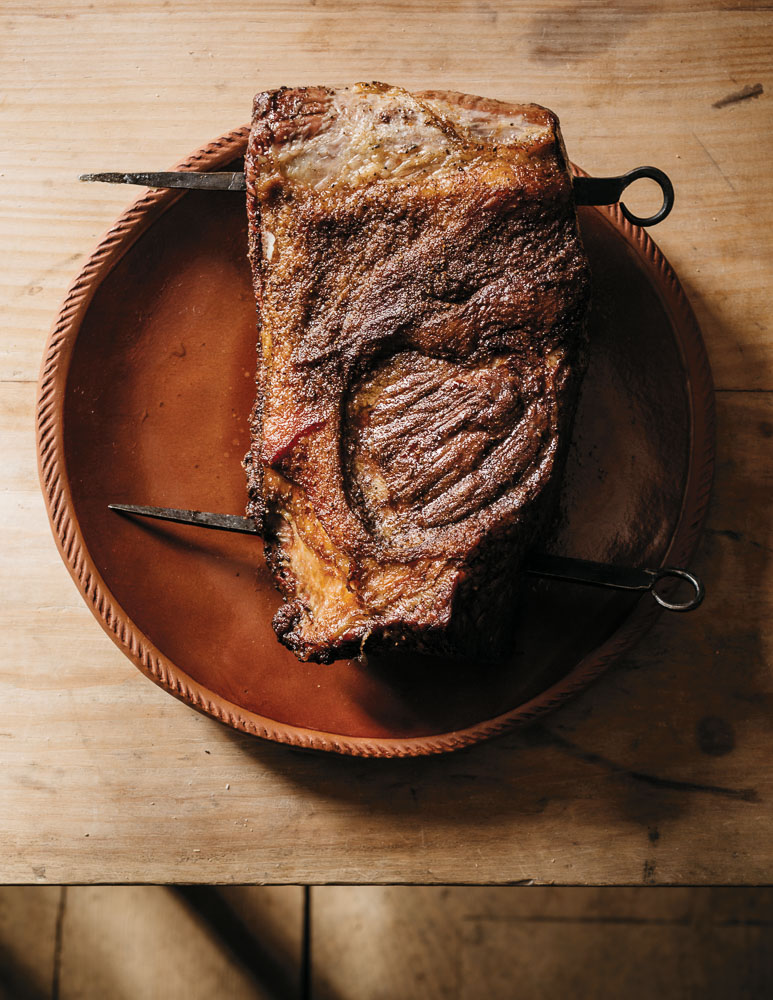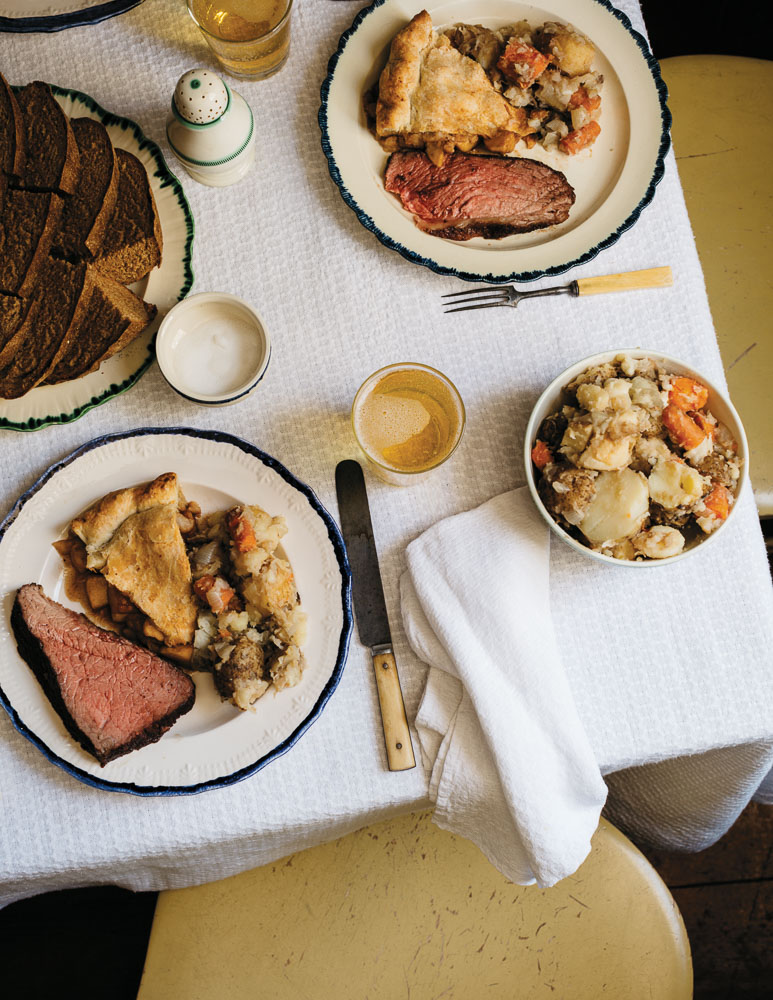A Taste of History
PHOTOS BY MICHAEL PIAZZA
The aroma of beef roasting in the massive fireplace was heady. The meat’s juices crackled as they dripped into a pan below the spit where the prime rib slowly revolved. Powerful sensory lures, these sights, sounds and smells drew me into the dining room at Bullard Tavern in Old Sturbridge Village. I was there as a time traveler of sorts, one of a group of some 40 visitors from the 21st century who were partaking of a Hearthside Bounty dinner.
Throughout the spring, fall and winter, the museum offers meals similar to those that would have been served to guests in the mid 19th century, transporting guests back in time to learn how their ancestors survived the long New England winters with convivial gatherings focused on food.
Watching the prime rib rotate, I was intrigued by the clock jack—a contraption of gears, wheels and rope fastened to the fireplace mantel that turned the roast on the spit. A crank at one end pulls up a weight and as the weight makes its way down toward the floor, the gears turn a wheel that rotates the spit. I was eager to give the crank a turn myself, but was swiftly and smoothly deflected by Linda Oakley, a costumed interpreter who portrayed the tavern owner’s wife.
The lady of the tavern was firmly in charge of the hearth and the production of the meal; she was having no part of guests interfering with the main course. Oakley directed me to a table next to the fireplace where a trifle was being assembled for dessert. A large bowl of heavy cream needed whipping, one of many examples of her multi-tasking.
“Help yourself to the whisk,” she said, pointing out a cluster of stripped birch branches tied together with twine.
Guests at Hearthside Bounty dinners can help whip the cream, but for the most part, the evening is designed for fun with a side of history provided by the museum’s interpreters.
Hearthside Bounty dinners take place in the museum’s Bullard Tavern, named for Cromwell Bullard, who owned and operated a tavern in Sturbridge in the 1830s.
Museum interpreter Will Contino, the genial host of the evening, welcomed us with mugs of steaming apple cider and answers to our questions. He’s a human Wikipedia of New England in the 19th century.
Before guests arrived Contino had carefully stacked wood and kindling in the tavern parlor’s fireplace and warmed big stoneware pitchers of apple cider at fire’s edge. Before serving, he plunged a red-hot loggerhead, an iron ball at the end of a long wooden handle, into each pitcher to give an extra boost of heat and caramelize the natural sugars in the apple juice.
Contino explained that in the 19th century the cider every-one drank contained from 4% to 7% alcohol; hard cider was distilled—more like today’s apple brandy. The cider served at the hearthside dinner is mulled with cinnamon sticks, allspice and cloves, but contains no alcohol. For 21st century visitors, however, there is a well-stocked bar across the room.
We helped ourselves to a tangy mound of pounded cheese, another staple of the era. It’s made from cheddar cheese mixed with butter, cayenne pepper, sherry and a dash of curry powder. Another stereotype punctured: Our New England ancestors were fond of spicy food.
Earlier I had spoken with Ryan Beckman, manager of historic foodways at Old Sturbridge Village. “Curry was not at all unusual as an ingredient,” Beckman explained. “By the early 19th century, the United States was trading with every country in the world except Japan and many local apothecaries sold curry powder along with cure-alls and dyes.”
A popular cookbook at the time, The American Frugal Housewife by Lydia Child (no relation to Julia), had curry powder in several recipes—or receipts, as they were called in the day. Contino pointed out that receipts were nothing more than a list of ingredients. “It was assumed you paid attention when your mother was making bread or pie so you knew the techniques,” he said.
Hearthside Bounty dinners showcase food traditionally served to travelers as well as to the men of the village who stopped by the tavern in the evening to catch up on the news or play a game of backgammon, dice or cards.
“The tavern was a combination rest stop and inn for stage-coaches, which came once or twice a day,” Beckman said. Sturbridge was then, as it is now, the focus of roads to Hartford and New York, where routes U.S. 20 and I-84 converge. Stage-coaches would typically stop at Sturbridge before continuing on to Boston, another two hours on the road.
In the 1830s in Massachusetts, a typical tavern menu would include a boiled vegetable like parsnips and pie served with the meal, not as dessert. In a pre-cursor to Yelp, “travelers com-mented on and compared the quality of pie from inn to inn,” Beckman noted.
The menu for our dinner included roasted root vegetables and scalloped potatoes prepared behind the scenes in the tavern’s modern kitchen. Our utensils, however, were straight from the 19th century. Contino instructed us on how to use the two-tined fork to spear pieces of food and move them onto the wide-blade knife. Putting a fork in your mouth was not yet in fashion in Massachusetts in 1830.
“Be careful and make sure the sharp edge of the knife blade is pointed away from you before you put it into your mouth,” he advised. “Shoveling your food into your mouth [with a knife] was common, but frowned upon,” Oakley added.
The food served at Hearthside Bounty dinners is procured by the museum’s culinary department. “To keep the price of the meal affordable we don’t normally have locally sourced ingre-dients,” Beckman told me, though sometimes dinners in the fall might include potatoes or vegetables grown on the museum’s farms. For private functions, if requested, staff will source local or organic ingredients.
During dinner, Peter Oakley, another interpreter and husband of Linda, provided musical entertainment. He played waltzes and lively ditties on a series of historically correct instruments including a fiddle, concertina, mandolin and tin whistle. The Oakleys met at Old Sturbridge Village and have worked there for 36 years.
As the evening came to a close, Oakley’s tunes piped our group of diners out the door and into the cold, dark night. Lan-terns lit the village path as we made our way back to the parking lot and wistfully back into the 21st century.
Old Sturbridge Village offers hearthside cooking events through-out the fall and winter; check OSV.org for more information.
This story appeared in the Spring 2017 issue.







